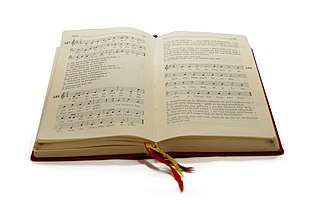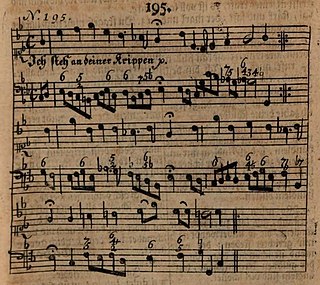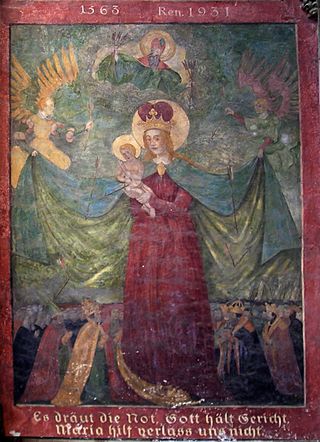Melody

| "Maria, dich lieben ist allzeit mein Sinn" | |
|---|---|
| Marian hymn by Anonymous | |
| English | Mary, to love you is always on my mind |
| Written | 18th century, last revised 1972 |
| Text | Unknown author, revised by Heinrich Bone, Joseph Mohr and Friedrich Dörr |
| Language | German |
"Maria, dich lieben ist allzeit mein Sinn" (Mary, to love you is always on my mind) is a Marian hymn in German. It was created in the beginning of the 18th century as "Maria zu lieben, ist allzeit mein Sinn" (Loving Mary is always on my mind), and became the most popular Marian hymn in German. The common Catholic hymnal in German, Gotteslob , has a version modernised by Friedrich Dörr that already appeared in its first edition from 1975. It shares with the older version only the first line.
The author and composer of the hymn "Maria zu lieben, ist allzeit mein Sinn" are unknown. It was created in the beginning of the 18th century, and became the most popular Marian hymn in German. [1] [2] The text expresses in erotic language the spiritual love of the lyrical subject, to Mary, mother of Jesus. The song was possibly derived from a secular love song. [3] It was used to conclude a pilgrimage to a place dedicated to Mary, describing the close relationship that had developed between the pilgrim and Mary. [4]
The song was extant in several versions reproduced in leaflets, until Heinrich Bone created a version in his 1847 hymnal Cantate! , which reduced the text to five stanzas. His version is focused on intimate love with an outlook into eternal life. [4] : 122–123
Joseph Mohr created a version in nine stanzas, based on Bone and earlier sources, namely leaflets from Meschede (1752) and Paderborn (1765); his version incorporates doctrines. [4] : 123–125 It was one of 23 Einheitslieder (common songs) that a 1916 bishops' conference in Fulda created. [4] : 124 When a second approach to unify German Catholic hymns was undertaken by a bishops' conference in 1947, resulting in 72 songs, three of the additional stanzas were cut, resulting in the song's period of highest publication. [4] : 125–126
The first edition of the Gotteslob contained a version that retained only the (modified) first line from the original song, written by Friedrich Dörr, as GL 594. [5] It was transferred without change to the 2013 edition as GL 521. [6]


"Gott sei gelobet und gebenedeiet" is a Lutheran hymn of 1524 with words written by Martin Luther who used an older first stanza and melody. It is a song of thanks after communion. Luther's version in three stanzas was printed in the Erfurt Enchiridion of 1524 and in Johann Walter's choral hymnal Eyn geystlich Gesangk Buchleyn the same year. Today, the song appears in German hymnals, including both the Protestant Evangelisches Gesangbuch, and in a different version in the Catholic Gotteslob.

"Maria durch ein Dornwald ging" is a German Advent song. By origin it was a pilgrimage song that initially was spread orally in the 19th century, starting in the Catholic Eichsfeld.

The 1975 edition of Gotteslob was the first combined prayerbook and hymnbook authorised by the bishops of all German-speaking Roman Catholics in Germany and Austria. It contains texts and songs for liturgy, communal prayer and private prayer, divided into a section which is common for all, and an appendix for the local songs in a diocese.

"Was mein Gott will, das g'scheh allzeit" is a Lutheran hymn in German. The text from c. 1550 is attributed to Albert, Duke of Prussia. The melody, Zahn No. 7568, goes back to a tune by Claudin de Sermisy, written in 1529 for a secular French song. The hymn has belonged to core Lutheran hymnody without interruption and is part of the Protestant hymnal Evangelisches Gesangbuch as EG 364.
"Den Herren will ich loben" is a Christian hymn by Maria Luise Thurmair, based on the Magnificat and set to a 1613 melody by Melchior Teschner, which was used for "Valet will ich dir geben". The hymn in three stanzas of eight lines was first written in 1954, and revised in 1971. It appeared in the Catholic hymnal Gotteslob in 1975, and in the current Gotteslob, but also in a German Protestant hymnal. A general song of praise, it has been set to music several times.

"Ich will dich lieben, meine Stärke" is a sacred poem by Johann Scheffler who is known by his pen name Angelus Silesius. It appeared first in a poem collection, Heilige Seelen-Lust in 1657, and has become a Christian song in notable hymnals of different denominations, with different melodies.

"Ich steh an deiner Krippen hier" is a German Christmas hymn, with lyrics by Paul Gerhardt which were first published in 1653. It was then sung with an older melody by Martin Luther, but a melody which was likely created by Johann Sebastian Bach for Schemellis Gesangbuch of 1736 is now part of current Protestant and Catholic hymnals.

"Zu Bethlehem geboren" is a German Christmas carol. The text is attributed to Friedrich Spee, and was first printed in the collection Geistlichen Psälterlein by Johannes Heringsdorf in Cologne in 1637. The author was unknown until the 20th century, but research of style and content arrived at the attribution. The song was printed with a then-popular secular melody in 1638. The song appears in current Catholic and Protestant hymnals.
"Nun freue dich, du Christenheit" is a Catholic hymn for Easter. It goes back to a 1390 hymn, which later appeared as "Freu dich, du werte Christenheit". The final version appeared first in the Catholic hymnal Gotteslob of 1975, later in several regional sections of the Gotteslob.

"Ein Haus voll Glorie schauet" is a popular German Catholic hymn, frequently sung for the consecration of churches (Kirchweihe) and their anniversaries. Text and tune were created by Joseph Mohr in 1875. It was changed significantly for the version in the Catholic hymnal Gotteslob, with stanzas two to five written by "Hans W. Marx" in 1972. It has inspired musical settings for festive occasions such as the millennium of the Bamberg Cathedral.

Heinrich Bone was a German educator and hymnwriter. He wrote a reader for German studies which was used for higher education in Germany, Belgium, Luxembourg and Austria, until it was banned during the Kulturkampf. He published a hymnal, Cantate!, which was used by several Catholic dioceses and became a model for common hymnals. Some of his own hymns, including paraphrases of Latin hymns, are part of recent hymnals, both Catholic and Protestant, such as "Komm, Schöpfer Geist, kehr bei uns ein" as a paraphrase of the 9th-century hymn for Pentecost, Veni Creator Spiritus.
Friedrich Dörr was a German Catholic priest and professor of theology, who is known as a hymnwriter. He shaped the first common German Catholic hymnal, Gotteslob, published in 1975.

Cantate! (Sing!) is a German Catholic hymnal first published in 1847, and continued in seven editions until 1879. It was a collection of 444 old and new songs, edited by the educator and hymnwriter Heinrich Bone, and the first Catholic hymnal in German that was used in multiple dioceses. Several of the songs are still part of the common Catholic hymnal in German, Gotteslob.
"Kündet allen in der Not" is a Christian hymn with German text by Friedrich Dörr written in 1971 to a 1662 melody by Johann Rudolf Ahle. The song is part of the German Catholic hymnal Gotteslob.

"Mit Ernst, o Menschenkinder" is an Advent hymn by Valentin Thilo. It partly paraphrases the call to penitence by John the Baptist. The text was first published in 1642 in the collection Preußische Festlieder. The different melody that later became popular dates back to 1557.
"Lobpreiset all zu dieser Zeit" is a Christian hymn in German for a new year with text by Heinrich Bone written in 1851. It is contained in the Catholic hymnal Gotteslob. It is sung to a melody that Martin Luther created in 1529.
"Segne du, Maria" is a Christian Marian hymn in German with text by Cordula Wöhler in 1870, and a melody composed by Karl Kindsmüller and published in 1916, after the author's death. On popular demand, it is contained in the Gotteslob of 2013, and other hymnals and songbooks.
"Freu dich, du Himmelskönigin" is a Marian hymn for Eastertide, a paraphrase of the Latin Regina caelifirst published in 1600. It has appeared in German hymnals and songbooks.

"Gegrüßet seist du, Königin" is a Catholic hymn, based on a hymn to Mary in Latin, Salve Regina. Singers call Mary, the mother of Jesus, with many attributes and request her help in the misery of the world. The first version was published in 1687 by Johann Georg Seidenbusch. It became part of hymnals with several melodies. The 2013 common German hymnal Gotteslob has a version in six stanzas as GL 536, with a melody first published in Mainz in 1712. In the U.S., the song became popular with a 1736 melody from Hildesheim.

"Maria, breit den Mantel aus" is one of the most popular Marian hymns in German, first printed in 1640.